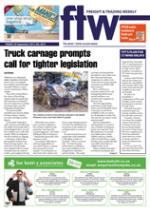The SA Revenue Service (Sars)
strategy for combating illicit
trade in clothing and textiles is
on the right track.
“It contains the right
elements to overcome this
problem for SA producers,”
Brian Brink, CEO of the Textile
Federation, told FTW.
He also approved of
government having introduced
incentive schemes (production
incentives will be increasingly
grant-based, thus reducing
reliance on tax incentives) to
boost manufacturing capacity
and support job creation.
According to Sars, the
industry – to be competitive
across the entire value chain
– would have to improve,
amongst other things, its design
capability; the technology used;
its productivity; and how it
markets SA-produced goods.
To protect what it described
as “strategic industries”
against the flow of illicit goods,
it has put in place several
interventions.
It has, for example,
developed a price-referencing
system which has been built
into the risk-engine of customs
to ensure that imports and
exports that present high risk,
or goods that are priced out
of the norm, are stopped for
inspections.
It is also improving its
ability to identify high-risk
transactions more accurately
and intends
to impose the
most punitive
measures
possible in
respect of its
penalty regime
on offenders.
Under
its control
of importer
registrations, it
will withdraw
registrations
for offenders
– while at the same time also
withdrawing licensing for
warehouses and clearing agents
where they are found to have
conspired with offenders.
Backing this up, the new
Tax Administration Act
has introduced additional
investigative powers. Also,
a new set of Customs Bills is
currently before Parliament
which will seek
to strengthen
the legal means
available to Sars
to execute its
mandate.
Looking at
the elements
directed at
the industry,
Brink felt that
the design
capability was
achievable.
“First it has to
be noted that there are
the two types of designers –
one for textiles and the other
for clothing. But there is a
pool of both types of designers
in this country.
“Certain types of training
and skills certainly have to
be developed, but there are
good design schools producing
skilled and talented designers
in both categories.”
On the development of
technology, Brink also felt
that this was attainable –
particularly with the incentive
schemes now in place. Stateof-
the-art capital equipment
is anything but cheap, but this
was overcome by government’s
moves to stimulate the
textile and clothing sectors.
“Production incentives,” he
told FTW, “can only be spent
on new equipment, technology
and skills training, so cost is
adequately covered by this
scheme. The age of equipment
has already been improved
considerably, with more
efficient equipment having
been put in place.”
Industry marketing, Brink
added, is also up to par.
Regarding the pricereferencing
system and Sars
improving its ability to identify
high-risk transactions more
accurately, he was convinced
that these were extremely viable
tools in combating the inflow of
illicit imports.
“Accurately targeting suspect
entities will help Sars, and
overcome its lack of personnel,”
Brink said. “Also honourable,
compliant traders will be
excused stoppages of containers
for examination, something
that has been a problem for
them in the past under the
random checking system.
“It makes sense, although
no doubt a few law-abiding
people will get caught in the
net until the high-risk engine is
operating smoothly.”
INSERT & CAPTION
Accurately targeting
suspect entities
will help Sars, and
overcome its lack of
personnel.
– Brian Brink

